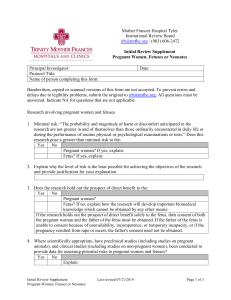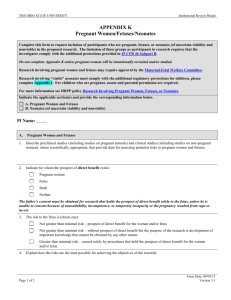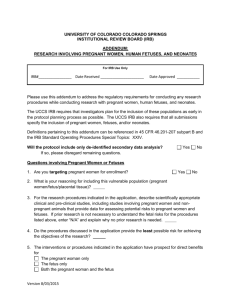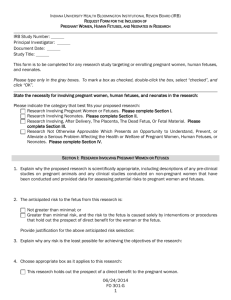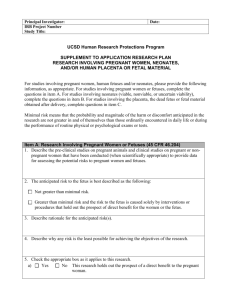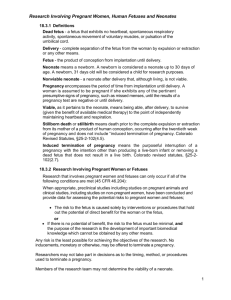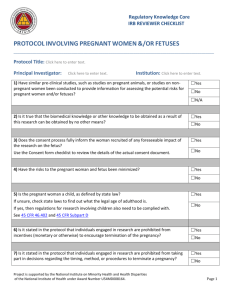II4A-B CH Review of Research Involving Pregnant Women, Human
advertisement
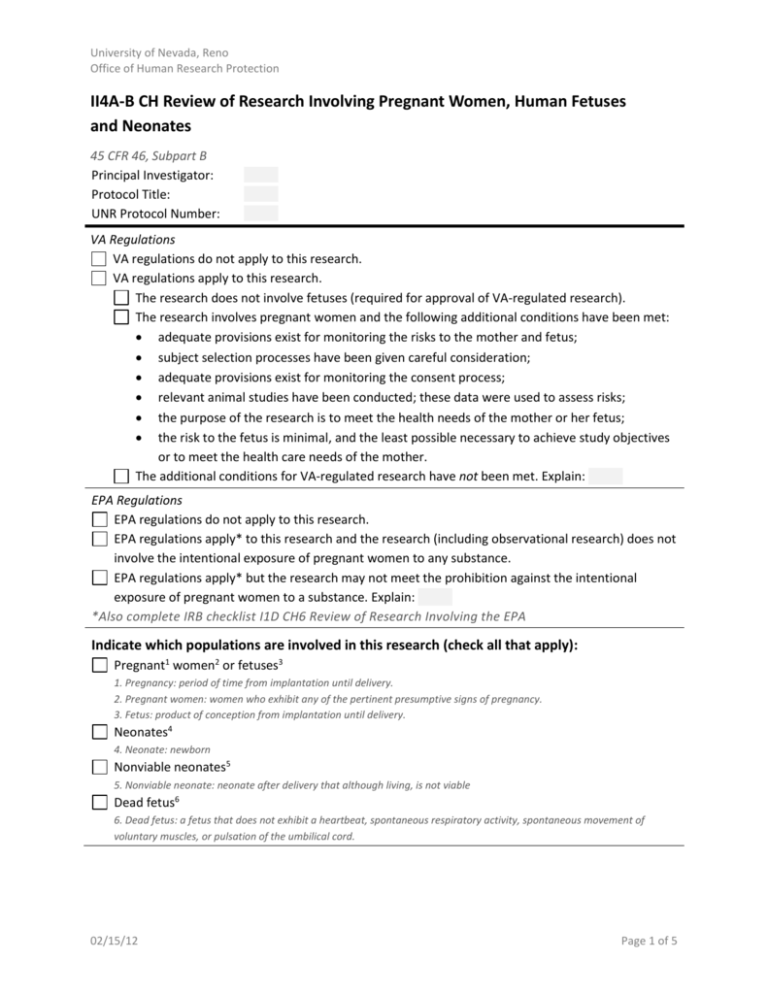
University of Nevada, Reno Office of Human Research Protection II4A-B CH Review of Research Involving Pregnant Women, Human Fetuses and Neonates 45 CFR 46, Subpart B Principal Investigator: Protocol Title: UNR Protocol Number: VA Regulations VA regulations do not apply to this research. VA regulations apply to this research. The research does not involve fetuses (required for approval of VA-regulated research). The research involves pregnant women and the following additional conditions have been met: adequate provisions exist for monitoring the risks to the mother and fetus; subject selection processes have been given careful consideration; adequate provisions exist for monitoring the consent process; relevant animal studies have been conducted; these data were used to assess risks; the purpose of the research is to meet the health needs of the mother or her fetus; the risk to the fetus is minimal, and the least possible necessary to achieve study objectives or to meet the health care needs of the mother. The additional conditions for VA-regulated research have not been met. Explain: EPA Regulations EPA regulations do not apply to this research. EPA regulations apply* to this research and the research (including observational research) does not involve the intentional exposure of pregnant women to any substance. EPA regulations apply* but the research may not meet the prohibition against the intentional exposure of pregnant women to a substance. Explain: *Also complete IRB checklist I1D CH6 Review of Research Involving the EPA Indicate which populations are involved in this research (check all that apply): Pregnant1 women2 or fetuses3 1. Pregnancy: period of time from implantation until delivery. 2. Pregnant women: women who exhibit any of the pertinent presumptive signs of pregnancy. 3. Fetus: product of conception from implantation until delivery. Neonates4 4. Neonate: newborn Nonviable neonates5 5. Nonviable neonate: neonate after delivery that although living, is not viable Dead fetus6 6. Dead fetus: a fetus that does not exhibit a heartbeat, spontaneous respiratory activity, spontaneous movement of voluntary muscles, or pulsation of the umbilical cord. 02/15/12 Page 1 of 5 II4A-B CH Review of Research Involving Pregnant Women, Human Fetuses and… 45 CFR 46.204 Research Involving Pregnant Women or Fetuses Research involving pregnant women or fetuses may be approved only if conditions (a)-(j) are met. (a) Where scientifically appropriate, preclinical studies, including studies on pregnant animals; and clinical studies, including studies on nonpregnant women, have been conducted and provide data for assessing potential risks to pregnant women and fetuses. (b) The risk to the fetus is caused solely by interventions or procedures that hold out the prospect of direct benefit for the woman or the fetus; or if there is no such prospect of benefit, the risk to the fetus is not greater than minimal* and the purpose of the research is the development of important biomedical knowledge which cannot be obtained by any other means. *Minimal Risk: The probability and magnitude of harm or discomfort anticipated in the research are not greater in and of themselves than those ordinarily encountered in daily life or during the performance of routine physical or psychological examinations or tests. (c) Any risk is the least possible for achieving the objectives of the research. (d) If the research holds out the prospect of direct benefit to the pregnant woman, the prospect of a direct benefit both to the pregnant woman and the fetus, or no prospect of benefit for the woman nor the fetus when risk to the fetus is not greater than minimal and the purpose of the research is the development of important biomedical knowledge that cannot be obtained by any other means, the mother’s consent is obtained in accordance with the regulatory requirements for informed consent. (e) If the research holds out the prospect of direct benefit solely to the fetus then the consent of the pregnant woman and the father is obtained in accordance with the regulatory requirements for informed consent, except that the father's consent need not be obtained if he is unable to consent because of unavailability, incompetence, or temporary incapacity; or the pregnancy resulted from rape or incest. (f) Each individual providing consent under paragraph (d) or (e) of this section is fully informed regarding the reasonably foreseeable impact of the research on the fetus or neonate. (g) For children who are pregnant, assent and permission are obtained in accordance with regulatory requirements and Policy II4A-D Participation of Children in Research. (h) No inducements, monetary or otherwise, will be offered to terminate a pregnancy. (i) Individuals involved in the research will have no part in any decisions as to the timing, method, or procedures used to terminate a pregnancy. (j) Individuals engaged in the research will have no part in determining the viability of a neonate. Assessment of Requirements for Research Involving Pregnant Women and Fetuses All of the 10 conditions (above) for approval have been met. Revisions are required to satisfy some or all of the conditions for approval. Justify decision and note requested revisions: 45 CFR 46.205 Research Involving Neonates N/A, research does not involve neonates. Skip to section 45 CFR 46.206. (a) Neonates of uncertain viability and nonviable neonates may be involved in research only if conditions (1)-(4) are met: 02/15/12 Page 2 of 5 II4A-B CH Review of Research Involving Pregnant Women, Human Fetuses and… (1) Where scientifically appropriate, preclinical and clinical studies have been conducted and the data were used in assessing potential risks to neonates. (2) Each individual providing consent under items (b)(2) or (c)(5) (see the following two sections) is fully informed regarding the reasonably foreseeable impact of the research on the neonate. (3) Investigators engaged in the research will have no part in determining the viability of a neonate. (4) The requirements of section (b) related to neonates of uncertain viability or section (c) related to nonviable neonates have been met as applicable. Assessment of Requirements for Research with Neonates of Uncertain Viability or Nonviable Neonates The four conditions have been met. Revisions are required to satisfy some or all of the conditions for approval. Justify decision and note requested revisions: (b) Neonates of Uncertain Viability: Until it has been ascertained whether or not a neonate is viable, a neonate may not be involved in research unless the following additional conditions have been met: (1) The IRB determines that (i) The research holds out the prospect of enhancing the probability of survival of the neonate to the point of viability, and any risk is the least possible for achieving that objective, or (ii) the purpose of the research is the development of important biomedical knowledge which cannot be obtained by other means and there will be no added risk to the neonate resulting from the research; and (2) The legally effective informed consent of either parent of the neonate or, if neither parent is able to consent because of unavailability, incompetence, or temporary incapacity, the legally effective informed consent of either parent's legally authorized representative is obtained in accordance with the regulatory requirements of informed consent except that the consent of the father or his legally authorized representative need not be obtained if the pregnancy resulted from rape or incest. Assessment of Requirements for Research with Neonates of Uncertain Viability N/A, research does not involve neonates of uncertain viability. Both conditions have been met. Information is needed to determine if the research may involve neonates of uncertain viability or revisions are needed to satisfy the conditions for approval of research involving neonates of uncertain viability. Justify decision and note requested revisions: 02/15/12 Page 3 of 5 II4A-B CH Review of Research Involving Pregnant Women, Human Fetuses and… (c) Nonviable Neonates: After delivery nonviable neonates may not be involved in research covered by this policy unless all of the following additional five conditions are met: (1) Vital functions of the neonate will not be artificially maintained; (2) The research will not terminate the heartbeat or respiration of the neonate; (3) There will be no added risk to the neonate resulting from the research; (4) The purpose of the research is the development of important biomedical knowledge that cannot be obtained by other means; and (5) The legally effective informed consent of both parents of the neonate is obtained in accord with regulatory requirements, except that the consent of the father need not be obtained if the pregnancy resulted from rape or incest. The waiver and alteration provisions of 45 CFR 46.116(c) and (d) do not apply. If either parent is unable to consent because of unavailability, incompetence, or temporary incapacity, the informed consent of one parent of a nonviable neonate will suffice to meet the requirements of this paragraph. The consent of a legally authorized representative of either or both of the parents of a nonviable neonate will not suffice to meet the requirements. Assessment of Requirements for Research with Nonviable Neonates N/A, research does not involve nonviable neonates. The five conditions have been met. Information is needed to determine if the research may involve nonviable neonates or to satisfy some or all of the conditions for approval of research involving nonviable neonates. Justify decision and note requested revisions: (d) Viable neonates: A neonate, after delivery, that has been determined to be viable may be included in research only to the extent permitted by and in accordance with the requirements for research with human subjects and research involving children (see Policy II4A-D). Assessment of Requirements for Research with Viable Neonates N/A, research does not involve viable neonates. Research involves viable neonates; IRB checklist II4A-D for research with children is required. Information is needed to determine if the research involves viable neonates. Justify decision and note requested revisions: 45 CFR 46.206 Research Involving, after Delivery, the Placenta, Dead Fetus or Fetal Material N/A, research does not involve the placenta, dead fetus, or fetal materials. The research involves the placenta, dead fetus or fetal material and the following conditions have been met: (a) Research involving, after delivery, the placenta; the dead fetus; macerated fetal material; or cells, tissue, or organs excised from a dead fetus, shall be conducted only in accord with any applicable Federal, State, or local laws and regulations regarding such activities. (b) If information associated with material described in paragraph (a) of this section is recorded for research purposes in a manner that living individuals can be identified, directly or through identifiers linked to those individuals, those individuals are research subjects and all pertinent regulations 45 CFR 46 Subpart B apply. 02/15/12 Page 4 of 5 II4A-B CH Review of Research Involving Pregnant Women, Human Fetuses and… Assessment of Requirements for Research Involving the Placenta, Dead Fetus or Fetal Material Both conditions have been met. Revisions are required to satisfy both conditions. Justify decision and note requested revisions: 45 CFR 46.207 Research Not Otherwise Approvable For research not otherwise approvable which presents an opportunity to understand, prevent, or alleviate a serious problem affecting the health or welfare of pregnant women, fetuses, or neonates, the Secretary will conduct or fund research that the IRB does not believe meets the requirements of Sections § 46.204 or § 46.205 only if the following conditions are met: (a) The IRB finds that the research presents a reasonable opportunity to further the understanding, prevention, or alleviation of a serious problem affecting the health or welfare of pregnant women, fetuses or neonates. (b) The Secretary, after consultation with a panel of experts in pertinent disciplines (for example: science, medicine, ethics, law) and following opportunity for public review and comment, including a public meeting announced in the Federal Register, has determined either: (1) That the research in fact satisfies the conditions of § 46.204, as applicable; or (2) The following are true: (i) The research presents a reasonable opportunity to further the understanding, prevention, or alleviation of a serious problem affecting the health or welfare of pregnant women, fetuses or neonates; (ii) The research will be conducted in accord with sound ethical principles; and (iii) Informed consent will be obtained in accord with the informed consent provisions of Subpart A and other applicable Subparts of this part. Assessment of Requirements for Research Not Otherwise Approvable Documentation has been provided to indicate that items (a) and (b)(1) apply (i.e., the Secretary determined that the research satisfies the conditions of § 46.204). Documentation has been provided to indicate that the Secretary has determined that items (a) and (b)(2) apply. Documentation of the Secretary’s determination is needed. Additional Considerations and Reviewer Determination Note additional comments, questions, or recommendations: Determination The requirements for research with pregnant women and fetuses have been satisfactorily met. Minor directed changes are required; IRB staff who are voting members of the IRB may verify that the revisions are satisfactory. Substantive changes or documentation are necessary to meet the requirements; send revisions to primary reviewer or IRB Chair for final approval (for expedited reviews). Substantive changes or documentation are required; place revisions on agenda for review at a convened IRB meeting. Reviewer Name 02/15/12 Review Date Page 5 of 5
